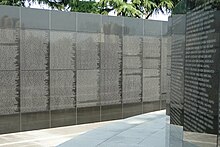Pemakaman Peringatan Perserikatan Bangsa-Bangsa
Artikel ini sebatang kara, artinya tidak ada artikel lain yang memiliki pranala balik ke halaman ini. Bantulah menambah pranala ke artikel ini dari artikel yang berhubungan atau coba peralatan pencari pranala. Tag ini diberikan pada Oktober 2022. |
Pemakaman Peringatan Perserikatan Bangsa-Bangsa (Hangul: 재한유엔기념공원; RR: Jaehahn yuen ginyeomgongwon),[10] terletak di Tanggok, Distrik Nam,[11] Kota Busan,[nb 1] Republik Korea, adalah sebuah halaman penguburan untuk para korban Komando Perserikatan Bangsa-Bangsa dalam Perang Korea.[nb 2] Pemakaman tersebut terdiri dari 2.300 makam dan merupakan satu-satunya pemakaman Perserikatan Bangsa-Bangsa di dunia. Berdiri di atas lahan seluas 14 hektar, pemakaman tersebut terdiri dari 22 situs yang dirancang menurut kewarganegaraan para anggota penugasan yang dikubur.[12]
| Pemakaman Peringatan Perserikatan Bangsa-Bangsa | |
|---|---|
재한유엔기념공원 | |
| Commission for the UNMCK (CUNMCK) | |
 Tembok Peringatan | |
| Dipakai untuk orang-orang yang gugur pada 1950–53 ditambah pasukan yang gugur pasca-perang | |
| Didirikan | 18 Januari 1951 (sebagai Pemakaman Militer Perserikatan Bangsa-Bangsa) |
| Lokasi | 35°7′41″N 129°5′49″E / 35.12806°N 129.09694°E 93 UN Pyeonghwa-ro, Nam-gu, Busan, 608-812, Republik Korea (alamat lama: 779 Daeyon 4-dong, Nam-gu, Busan) |
| Total makam | 2,300 |
| Makam menurut kebangsaan | |
Komando Perserikatan Bangsa-Bangsa:
| |
| Sumber statistik: * UN Memorial Cemetery (Official) * Korean War Memorials: UN Memorial Cemetery in Korea | |
| Pemakaman Peringatan Perserikatan Bangsa-Bangsa | |
| Hangul | |
|---|---|
| Hanja | |
| Alih Aksara | Jaehan yuen ginyumgongwon |
| McCune–Reischauer | Chaehan yuen kinyŏmgongwŏn |
Catatan
sunting- ^ As a transliteration from Korean, the city name 부산 (Pengucapan Korea: [pusʰan]) was typically spelled "Pusan" in McCune-Reischauer until 2000. The official Revised Romanization spells the name Busan. See "Pusan: South Korea". Geographical Names. Diakses tanggal August 15, 2011.
- ^ The Korean War started on June 25, 1950 when North Korean forces pushed south of the 38th parallel which divided Korea following World War II. With authorization from the United Nations, forces from the United States and other nations pushed the North Koreans back to the north. When these UN forces approached China, Chinese forces intervened and the battlefront eventually stabilized along the 38th parallel. The Korean Armistice was signed on July 27, 1953 to end the fighting.
Referensi
sunting- ^ Korean War casualties only. In 2012, the cremated remains of Archie Hearsay were buried with his brother, Joseph[pranala nonaktif permanen], who had died in Korea while both were serving. See: "Ashes of Canadian veteran buried beside brother in S. Korea". TBNewsWatch (Dougall Media). The Canadian Press. April 25, 2012. Diarsipkan dari versi asli tanggal February 24, 2014. Diakses tanggal February 19, 2014.
- ^ Brent, Winston A. (2001). 2 Squadron in Korea: Flying Cheetahs 1950–1953. Nelspruit: Freeworld Publications. hlm. 134. ISBN 978-0958388092. OCLC 174758735.
- ^ "Turkish Fallen of Korean War Remembered". Diplomatic Observer. Ankara: Över Publishing. 2002. Diarsipkan dari versi asli tanggal 2014-02-22. Diakses tanggal 2014-02-16.
- ^ Balkenende, Jan Peter (Perdana Menteri Belanda) (April 29, 2010). "Speech at the United Nations Memorial Cemetery in Busan". Documents and publications. Government of the Netherlands. Diarsipkan dari versi asli tanggal 2014-03-01. Diakses tanggal 2021-06-28.
- ^ "UNMCK: Status of Interred at the UNMCK". Diarsipkan dari versi asli tanggal 2020-08-10. Diakses tanggal 2021-06-28.
- ^ Dickon, Chris (2011). The Foreign Burial of American War Dead: A History. Jefferson, NC: McFarland & Co. hlm. 138, 141. ISBN 978-0786446124. OCLC 659753667.
- ^ "Korea 2007". Det Norske Kongehus. November 28, 2007.
Among [the soldiers] is Norwegian Second Engineer Reidar George Tveit ... Crown Prince Haakon [also] laid a wreath at the new monument commemorating the Norwegian soldiers ...
- ^ Reportedly of North Koreans who refused to be repatriated following the war because they had criticized the regime. See: Baldwin, R F (2013) [2011]. Seven Years in Asia: A Wander's Tale. Booksmango. hlm. 278. ISBN 978-6162450969. OCLC 781689455.
- ^ Some unidentified Americans were left as token representatives to the unknowns. Pash, Melinda L. (2012). In the Shadow of the Greatest Generation: the Americans who fought the Korean War . New York and London: New York University. hlm. 134. ISBN 978-0814767696. OCLC 777627052.
- ^ United Nations Memorial Cemetery, Korea
- ^ 1901st Engr. Topo. Bn., ROK Army. "Pusan (Korea) 1959". American Geographical Society Library Digital Map Collection.
Boundary Line Plan United Nations Memorial Cemetery
; also see: Korea 1:50,000 Pusan Sheet 7019 III (1947) and Pusan – 1947 – AMS Map Sheet L751 – 7109 III Diarsipkan 2014-02-28 di Wayback Machine. - ^ Clark, Donald N. (September 1996). "Part III: Smaller Foreign Cemeteries in the Provinces" (PDF). The Seoul Foreigners' Cemetery at Yanghwajin. Seoul, Korea: Seoul Union Church. hlm. 78. Diarsipkan dari versi asli (PDF) tanggal 2014-02-22. Diakses tanggal 2021-06-28.
Bacaan tambahan
sunting- Martz, Jr., John D. (May–June 1954). "Homeward Bound". Quartermaster Review. Fort Lee, VA: US Army Quartermaster Foundation. Diarsipkan dari versi asli tanggal 2013-11-02. A description of the post-interment processing of casualties undertaken at Kokura, Japan, in which they were identified and prepared for repatriation.
- United Nations Memorial Cemetery in Korea. Records, 1959–1974. OCLC 86160340.
Pranala luar
sunting| Cari tahu mengenai Pemakaman Peringatan Perserikatan Bangsa-Bangsa pada proyek-proyek Wikimedia lainnya: | |
| Gambar dan media dari Commons | |
| Entri basisdata #Q15465499 di Wikidata | |
| Panduan wisata di Central Busan dari Wikivoyage | |
- Situs web resmi
- South Africa War Graves Project: South Korea
- Korea 1953–1954 – for photographs of the cemetery in 1954 from the King's Own Royal Regiment Museum
- Wikivoyage Map Diarsipkan 2021-06-28 di Wayback Machine.
- UNMCK at WikiMapia
- Pemakaman Peringatan Perserikatan Bangsa-Bangsa di Find a Grave
- 161977660 Ereveld Tanggok (UN Memorial Park) di OpenStreetMap